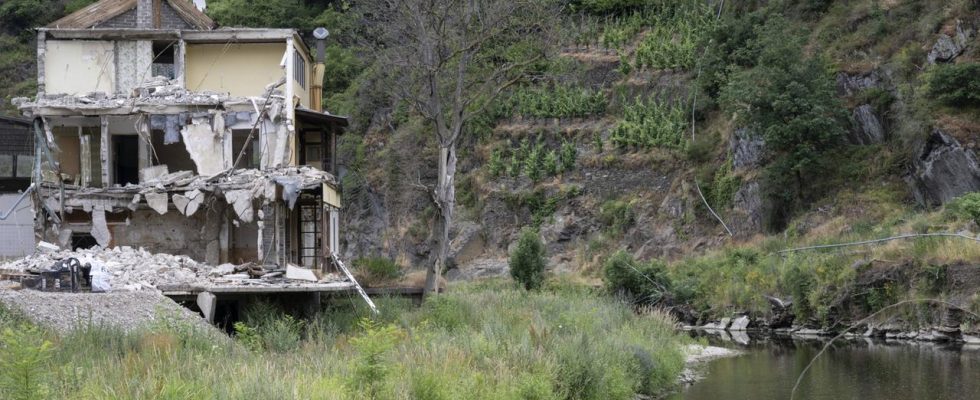Two years after the flood disaster, reconstruction on the Ahr is sometimes sluggish. It’s not the money. More of a regulation that makes additional flood protection measures more difficult.
Jörn Birkmann is on the Ahr. He heads the Institute for Regional Planning and Development Planning at the University of Stuttgart. The urban developer is always in the region as an independent expert.
“In many places, flood protection is neglected during reconstruction,” says Birkmann. “Due to climate change, we have to be prepared for extreme weather events such as more frequent heavy rain. Of course, this also applies to the Ahr Valley. The reconstruction should be planned and implemented accordingly.” There are many points to consider as to whether the same reconstruction at the same location really makes sense.
An example in Bad Neuenahr-Ahrweiler is the Don Bosco School, which stands on the Ahr and was badly damaged in the flood. The authorities do not yet know what will happen to the building. Birkmann has a clear recommendation: “You should check here: Isn’t there a better alternative in terms of construction and location?” The school is critical infrastructure in which there is a population worthy of protection who cannot evacuate themselves. “It makes little sense if you leave it directly on the Ahr,” says Birkmann.
However, the Rhineland-Palatinate administrative regulation for reconstruction prevents another location or measures against flooding. The Ministerialblatt of October 1, 2021 regulates what state financial aid from the multi-billion dollar flood relief fund is used for. After that there is only public money if it is rebuilt exactly as before the flood. Additional flood protection measures are not planned – and will not be paid for.
Urban developer Jörn Birkmann criticizes that flood protection is neglected during reconstruction in the Ahr valley.
damage repair, but not sustainable construction
A few blocks away, the managing director of the Bad Neuenahr-Ahrweiler construction company walks past a number of construction sites. Hermann-Josef Pelgrim draws a bitter interim assessment of the reconstruction. A big problem for him: the administrative regulation, which only focuses on repairing damage, but not on sustainable building.
“It is fatal for the public sector that we cannot build in a future-oriented and climate-resilient manner – for example with more trees, with measures in the water for flood protection,” says Pelgrim. “This does not correspond to the future requirements with regard to climate change.”
According to Pelgrim, Germany committed itself to these climate-resilient measures in the Paris climate agreement, for example. Due to the applicable administrative regulation, however, this cannot be legally implemented in the Ahr Valley. Pelgrim also wants a revision of the previous flood regulation.
But why are politicians and authorities planning a reconstruction without flood protection – especially in the Ahr Valley? Urban developer Birkmann recalls the first few weeks after the flood: “After the accident, the federal and state governments reacted quickly and 30 billion euros were made available for reconstruction. The time pressure was great. People wanted to go back to their homes.”
building law and administrative regulation independently of each other
At that time, people only thought about compensation for damage – not about climate-resilient reconstruction. “That should now be changed in the funding rules. At the moment, those who also invest in flood protection often pay extra. The federal, state, authorities and insurance companies should act.”
An approach that goes far beyond the reconstruction of individual buildings is also important. Birkmann therefore advocates an overall concept for the entire region. The aim must be to create an infrastructure that will not just meet the challenges of climate change for a few years, but for many decades.
The federal government had recently even changed the building code because of the Ahr valley flood. According to paragraph 246c, flood protection and climate resilience are to be expressly promoted in the future. The problem: from an administrative and legal point of view, building laws and administrative regulations are independent of one another. The changed framework conditions from Berlin have therefore not yet been included in the administrative regulations in Rhineland-Palatinate.
In the SWR summer interview Prime Minister Malu Dreyer therefore refers to the current legal situation – nothing more. “Whenever a complaint comes up, we always look: what can we do? If the funding guidelines are unclear, we bring everyone together,” says Dreyer. “It’s not distrust of the citizens. But we also have accountability to the federal government. That’s tax money. We have to use it in a way that makes it clear to the Court of Auditors.”
Sebastian Tetzlaff from Dernau is rebuilding his house – and feels left alone.
Residents feel left alone again
The administrative regulations of Rhineland-Palatinate also make it difficult for private individuals to protect themselves against future extreme weather. Sebastian Tetzlaff from Dernau has rebuilt his house. “The new building is flood-proof. The money came from my own savings and from my insurance,” says the craftsman.
But Tetzlaff also has to secure his property against future floods and completely rebuild it accordingly. However, the authorities do not want to bear the additional costs because these new protective measures did not exist before the flood.
“One keeps hearing that the money from the flood fund is still there, but that it won’t be distributed because of the many conditions. I don’t understand that,” Tetzlaff complains. “I’m still doing relatively well. But I know many other people here in the Ahr Valley who are having a much worse time with the reconstruction than I am. It’s just a disaster.”
Politicians had promised the people on the Ahr after the flood not to leave them alone. But that’s exactly how Tetzlaff feels: “Looking at my money and the new building and property with flood protection, I don’t know if I can keep the house on my own in the long run. I’ll see if I can do it – or not.”

